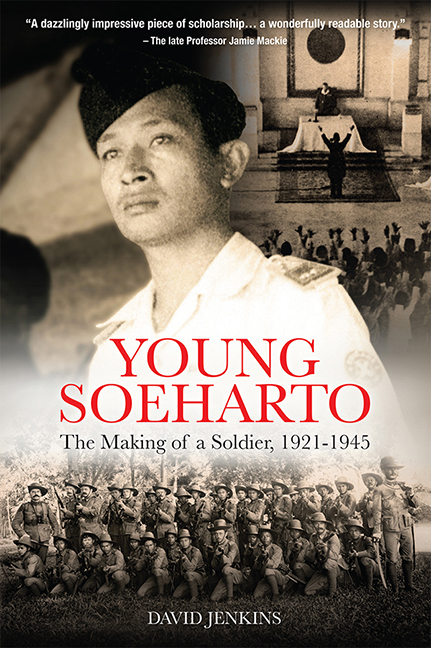Book contents
- Frontmatter
- Contents
- Foreword
- A Note on Spelling and Names
- A Note on Military Organization
- Maps
- List of Charts
- Preface
- Soeharto Family Tree
- 1 “The Sultan came to me and asked about that Family tree”
- 2 “The Cork on which the Netherlands Floats”
- 3 “They Regard Holland as a very Weak Power”
- 4 “An Invisible Motivating Force”
- 5 “What kind of Islam is this?”
- 6 “Soeharto is a Closed Book”
- 7 “I was Suited to the Disciplined life of the Military”
- 8 A Reassuringly Familiar World
- 9 A Policeman for the Japanese
- 10 An Armed Force Conjured out of Nothing
- 11 “The whole Island was Ablaze with Enthusiasm”
- 12 “Don’t make them too Strong!”
- 13 “Soeharto was a Cautious Man”
- 14 “Why did they Choose Soeharto?”
- Glossary and Abbreviations
- Notes
- Acknowledgements
- Bibliography
- Index
- About the Author
8 - A Reassuringly Familiar World
Published online by Cambridge University Press: 09 October 2021
- Frontmatter
- Contents
- Foreword
- A Note on Spelling and Names
- A Note on Military Organization
- Maps
- List of Charts
- Preface
- Soeharto Family Tree
- 1 “The Sultan came to me and asked about that Family tree”
- 2 “The Cork on which the Netherlands Floats”
- 3 “They Regard Holland as a very Weak Power”
- 4 “An Invisible Motivating Force”
- 5 “What kind of Islam is this?”
- 6 “Soeharto is a Closed Book”
- 7 “I was Suited to the Disciplined life of the Military”
- 8 A Reassuringly Familiar World
- 9 A Policeman for the Japanese
- 10 An Armed Force Conjured out of Nothing
- 11 “The whole Island was Ablaze with Enthusiasm”
- 12 “Don’t make them too Strong!”
- 13 “Soeharto was a Cautious Man”
- 14 “Why did they Choose Soeharto?”
- Glossary and Abbreviations
- Notes
- Acknowledgements
- Bibliography
- Index
- About the Author
Summary
Soeharto, now wearing the coveted collar patch of a KNIL corporal, left Central Java in July 1941 to join the 13th Battalion (Inf XIII), one of two infantry battalions garrisoned in the hill town of Malang in East Java. Built up over the previous fifty years to serve Dutch commercial interests, Malang stood on a saddle between two groups of mountains: the Kawi and Butak volcanoes were to the west; the impressive Tengger Caldera, which includes the Bromo and Semeru volcanoes, to the east and southeast. The majestic Arjuna volcano lay almost due north. More than 1,300 feet above sea level, Malang was pleasantly cool for most of the year, even cold at times. In 1941 it had a population of 200,000, including 11,000 Europeans. Malang owed its prosperity to the surrounding sugar, tobacco and rubber plantations. But it was also an important garrison town, home to the KNIL 6th Infantry Regiment (6 RI), which was responsible for East Java, with a force of three infantry battalions, two in Malang, the other in Surabaya. The 13th Battalion barracks were in the military quarter of Rampal, immediately east of the railway station in an area that looked more like a spacious colonial suburb than a military base, with the houses of senior officers and NCOs set down in large gardens, with shaded lawns and cascading bougainvillea.
Visitors arriving on foot made their way up Stationweg, a narrow road lined with tamarind trees, and turned right at the main gate. The barracks complex was built according to a standard KNIL formula, with a long, single-storey administrative block facing the road, a heavy enclosed wooden gate in the centre and a guardroom off to the right. Behind the gate and the office of the duty sergeant, with its typewriters, desks and rows of enormous keys (many of the original keys are still there today and still in use), lay the parade ground, which doubled as a soccer field. On each side and to the rear stood any number of neat, single-storey brick buildings, housing offices, classrooms, armouries, storehouses, kitchens, washing areas and row upon row of barracks. The buildings, which have not changed in nearly eight decades, are now home to Infantry Battalion 502, part of the Indonesian Army's Strategic Reserve (Kostrad), the unit Soeharto would command when he came to power in 1965.
- Type
- Chapter
- Information
- Young SoehartoThe Making of a Soldier, 1921–1945, pp. 154 - 172Publisher: ISEAS–Yusof Ishak InstitutePrint publication year: 2021

